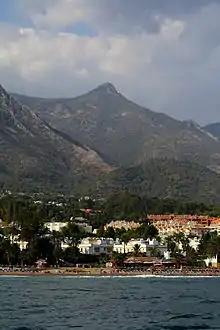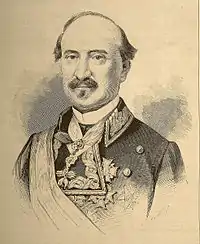Marbella blast furnaces
The Marbella blast furnaces (Spanish: altos hornos de Marbella) were the first iron works in Spain.

The blast furnaces in Marbella were built after the discovery of iron ore deposits in Ojén because of the availability of charcoal in the Sierra Blanca mountain range and the supply of water from the Verde River. In August and September 1826, two societies called La Concepción and El Angel were established, the first promoted by Manuel Agustín Heredia, the second by Joan Giró.
The furnaces at one time accounted for 75 per cent of the iron smelted in Spain, but iron produced in charcoal-fired kilns was much more expensive than that obtained by using coke as fuel; consequently the steel industry in Marbella died out due to competition from the more efficient steel producers of the north.
History

In 1828 Málaga businessman Manuel Heredia founded a company called La Concepción[1] to mine the magnetite iron ores[2] of the Sierra Blanca at nearby Ojén, due to the availability of charcoal made from the trees of the mountain slopes and water from the Verde River, as a ready supply of both was needed for the manufacture of iron. In 1832 the company built the first charcoal-fired blast furnace for non-military use in Spain;[3] these iron-smelting operations ultimately produced up to 75 per cent of the country's cast iron. In 1860 the Marqués del Duero founded an agricultural colony, now the heart of San Pedro de Alcántara.[4] The dismantling of the iron industry based in the forges of El Angel and La Concepción occurred simultaneously, disrupting the local economy, as much of the population had to return to farming or fishing for a livelihood. This situation was compounded by the widespread crisis of traditional agriculture, and by the epidemic of phylloxera blight in the vineyards,[5] all of which accounted for Marbella's high unemployment, increase in poverty, and the starvation of many day laborers.
The associated infrastructure built for the installation of the foundry of El Angel in 1871 by the British-owned Marbella Iron Ore Company[6] temporarily relieved the situation, and even made the city a destination for immigrants, increasing its population. However, the company did not survive the worldwide economic crisis of 1893, and closed its doors in that year due to the difficulty of finding a market for the magnetite iron ore removed from its mine.[7]
References
- Chris Evans; Göran Rydén (2005). The Industrial Revolution In Iron: The Impact Of British Coal Technology In Nineteenth-Century Europe. Ashgate Publishing, Ltd. p. 160. ISBN 978-0-7546-3390-7. Retrieved 28 January 2013.
- Aenaeus Bernardus Westerhof (1975). Genesis of magnetite ore near Marbella, southern Spain: formation by oxidation of silicates in polymetamorphic gedrite-bearing and other rocks. GUA. p. 13. Retrieved 28 January 2013.
- Joseph Harrison (1978). An Economic History of Modern Spain. Manchester University Press. p. 56. ISBN 978-0-7190-0704-0. Retrieved 28 January 2013.
- "Historia de San Pedro Alcántara Marqués del Duero". Ayuntamiento de Marbella Delegación de Comunicación. Archived from the original on September 6, 2012. Retrieved 29 January 2013.
- Great Britain. Parliament. House of Commons (1886). House of Commons Papers. H.M. Stationery Office. p. 344. Retrieved 28 January 2013.
- Gabriel Tortella Casares (2000). The Development of Modern Spain: An Economic History of the Nineteenth and Twentieth Centuries. Harvard University Press. p. 213. ISBN 978-0-674-00094-0. Retrieved 28 January 2013.
- José Bernal Gutierrez. "Comportamiento demográfico ante la inversión minera foránea. La población de Marbella en los inicios de la Marbella Iron Ore Company and Limited (1866–1874)" (PDF) (in Spanish). Universidad de Granada. p. 16. Archived from the original on May 19, 2005. Retrieved 12 April 2013.
Footnote 94: "En la última década del siglo, la crisis industrial viene acompañada de los primeros síntomas del declive minero: en 1893 se suspendió la explotación por la gran acumulación de existencias, y se va haciendo reconocible, al mismo tiempo, la poca disposición que la sociedad propietaria de las minas de l término, la ‘Marbella Iron Ore C&L’, demostró para renovar los sistemas tradicionales de extracción, y que a la postre redundaría en el paulatino agotamiento de las vetas” ( Vid LÓPEZ SERRANO, F. A. (2000): “Miseria, guerra y corrupción. Una aproximación a la Marbella de 1898", Cilniana , 13, pp. 4-17)
CS1 maint: unfit URL (link)
Bibliography
- García Montoro, C. Málaga en los comienzos de la industrialización: Manuel Agustín Heredia (1786–1846), 1978.
- Fernández, Álvarez y Portillo, Siderurgia malagueña en el siglo XIX. M.A.H.